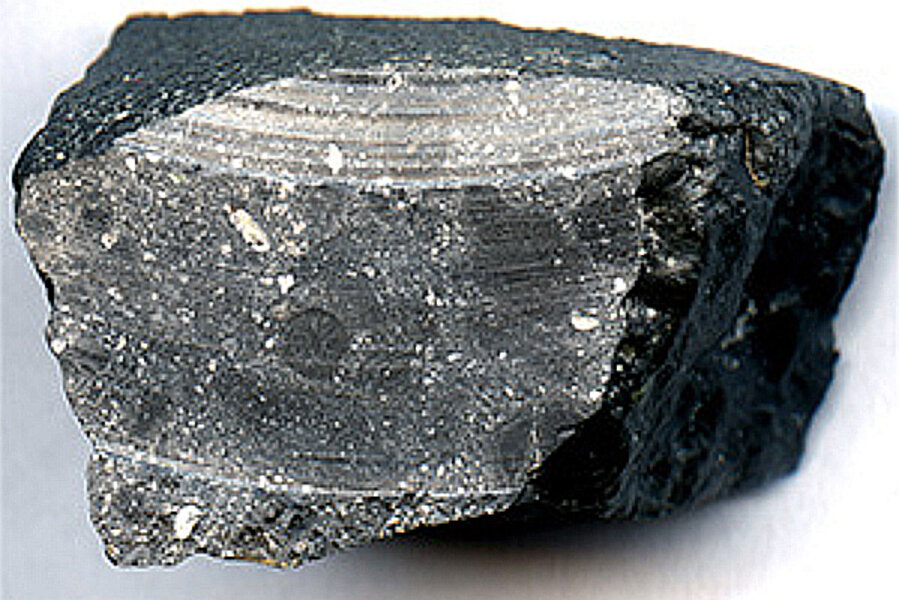'Black Beauty' reveals warm, wet dawn on Mars
Loading...
All rocks tell stories. Some are brief – "I erupted, then you picked me up." "I sat at the bottom of a lake for 500 million years."– while others have chapters upon chapters to share, with plot twists and daring escapes.
The rock dubbed "Black Beauty" has a "truly unique" story to tell, says planetary scientist Carl Agee. Born in the fires of Mars, it has tales to tell about volcanoes, meteorites, water on Mars – and then, in a shocking twist, it got blasted off the surface of Mars, it tumbled through space, and it got caught by Earth's gravity. When the meteor fell to Earth, part of it vaporized on impact and the rest was scattered across the desert of Western Sahara, where, a century or two later, passing nomads collected the scattered fragments and sold them to mineral collectors.
Dr. Agee ended up with one chunk, officially known as NWA 7034, while another piece, NWA 7553, fell into the hands of an international research team headed by Munir Humayun at Florida State University.
"This is a one-of-a-kind martian meteorite," says Agee, a professor at the University of New Mexico. "It's a once-in-a-lifetime find."
About a hundred other martian meteorites have been identified, but none like this one, he says. "This is a truly unique martian in that it is, first of all, the only martian true breccia."
Breccias are rocks composed of broken fragments or pebbles, welded together. In this case, the whole rock is the size of a fist, but the individual pieces are only a few millimeters across. They include at least six different types of igneous rocks as well what appear to be sedimentary rocks, says Agee. "This is almost as good as going to Mars and touring a geologic field area, sampling and picking up rocks off of this outcrop and that one, gathering them into your sample bag. Here, we have everything in one sample."
On Earth, breccias are typically cemented together by mud and water. That's probably not the case with Black Beauty, says Agee, but neither team of scientists has pinned down how the different fragments were welded together.
Two likely theories involve meteor impacts and volcanoes. "A lot of volcanoes, when they erupt, they do so explosively, and they can form breccias" as the flying fragments, thousands of degrees hot, slam into each other and are shock-welded as they cool. "Impact brecciation does a similar sort of thing: break up a rock and fuse it back together." So which mechanism is responsible for Black Beauty? "That's one of the things we're trying to figure out right now," says Agee.
As the teams began investigating the tiny rocks within the bigger meteorite, they pursued various avenues of study, sometimes leading to dead ends. "It's really like detective work. You pursue certain leads, and jump to conclusions, follow them, and then realize, oops, we've gotta go this way," says Agee.
Efforts at pinning down the age of the meteorite took several wrong turns, as the different fragments revealed different ages. This piece gave an age of 1.7 billion years, but this mineral measures 2.1 billion years, and then Dr. Humayun's team found zircons. "Whenever a geologist finds a zircon, it's like, 'Eureka!' Now we can get a definitive date," says Agee. Most martian meteorites do not have zircons, so the researchers hadn't been looking for them.
Unlike other minerals, which can be re-heated to near-melting temperatures and thus have their apparent age "reset," zircons hold their creation age. It's like trying to figure out the age of an ancient manuscript by getting a carbon-date off of some olive oil spilled on a page – and then discovering that the manuscript was already a thousand years old before the oil was spilled.
"Mars, just like Earth, is a geologically active planet, so there are all these other processes taking place that continually change the rock," says Agee. "That's the neat thing about these Martian rocks: They're so similar, in many ways, to Earth rocks."
Once they found the zircons, the meteorite revealed yet another shocking plot twist: it's 4.4 billion years old. Several other labs then independently confirmed the date. Our solar system formed about 4.5 billion years ago, so this rock is barely younger than the fires of planetary creation, and by very far the oldest martian meteorite ever found.
“This date is about 100 million years after the first dust condensed in the solar system,” said Humayun in a press release. “We now know that Mars had a crust within the first 100 million years of the start of planet building, and that Mars’ crust formed concurrently with the oldest crusts on Earth and the Moon.”
Other fragments revealed other tantalizing details: this meteorite has 10 times as much water within its crystal structure as any other martian meteorite ever discovered. "Now that it's clear it's got this ancient age, and then combined with the fact that it has lots and lots of water, and this is getting extremely interesting for astrobiology," says Agee.
Both teams have started looking for evidence of life, but the sediments are "extremely complicated," says Agee. The meteorite does contain organic carbon, but considering that it sat in the Sahara for over a century, Agee warns, "You need to be careful not to say, 'This is evidence for life on Mars!' when, no, it's evidence for life in the Sahara Desert."
"This meteorite is the kind of thing people live for," says Agee. "You could study this sample for years."








